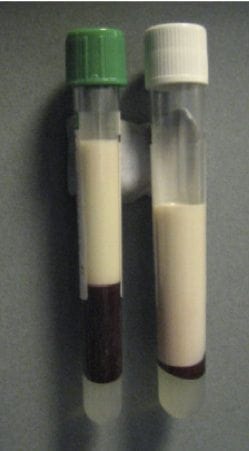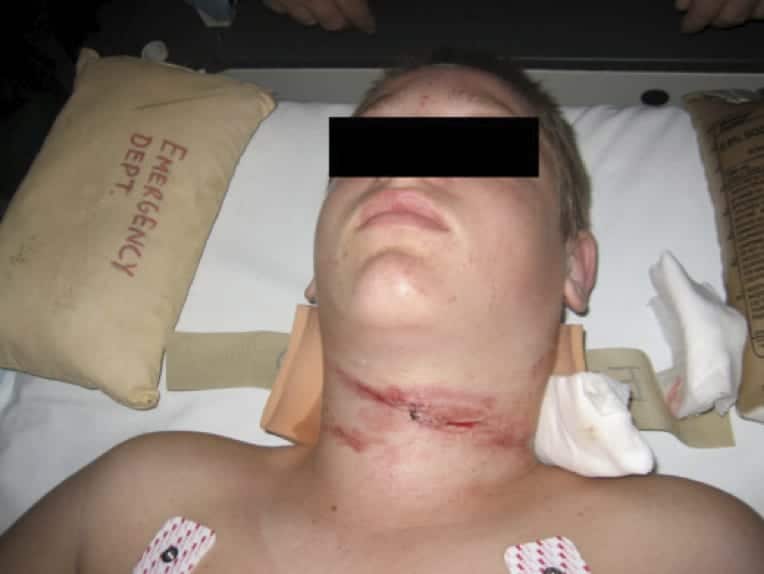CICM SAQ 2010.1 Q7
7.1. The following image is of the blood sample tubes into which a specimen of blood from a critically ill patient had been drawn by the phlebotomist.
- (a) What does this image show?
- (b) List three (3) causes for this appearance in blood samples from critically ill patients
- (c) If the condition causing this appearance in the blood tubes were to be long standing, what clinical signs specific to this condition may be found in this patient?
7.2. This is an image of a 13 year old boy who rode his motorbike into a single strand of fencing wire, was thrown off and walked 500 metres for help. He now complains of difficulty in breathing. On examination he has stridor.
- (a) How would you manage stridor in this boy?
- (b) How will you secure his airway? Give reasons.
Answers
Answer and interpretation
7.1. (a) What does this image show?
A creamy supernatant in blood tubes (serum and plasma) due to severe hypertriglyceridaemia (lipaemic serum).
7.1. (b) List three (3) causes for this appearance in blood samples from critically ill patients
- Familial hyperlipidemia
- Propofol infusion
- TPN use
- Pancreatitis from hyperlipidemia
7.1. (c) If the condition causing this appearance in the blood tubes were to be long standing, what clinical signs specific to this condition may be found in this patient?
Eyes
- Lipaemia retinalis
- Corneal arcus senilis
- Xanthelasma
Skin
- Xanthomata
- Tendon
- Eruptive
7.2 (a) How would you manage stridor in this boy?
- Oxygen
- Maintain spont vent in position of comfort until airway secure Nebulised adrenaline
- Heliox
- Prepare difficult airway equipment
- Call for assistance
7.2 (b) How will you secure his airway? Give reasons.
Options
- Tracheostomy under LA – the safest option available
- Awake fibreoptic intubation -may risk further laryngotracheal separation
- Gas induction with surgeon present for emergency tracheostomy
- Avoid cricothyroidotomy – risk of further damage
- RSI contraindicated – cricoid pressure may cause laryngotracheal separation

Examination Library
CICM
Chris is an Intensivist and ECMO specialist at The Alfred ICU, where he is Deputy Director (Education). He is a Clinical Adjunct Associate Professor at Monash University, the Lead for the Clinician Educator Incubator programme, and a CICM First Part Examiner.
He is an internationally recognised Clinician Educator with a passion for helping clinicians learn and for improving the clinical performance of individuals and collectives. He was one of the founders of the FOAM movement (Free Open-Access Medical education) has been recognised for his contributions to education with awards from ANZICS, ANZAHPE, and ACEM.
His one great achievement is being the father of three amazing children.
On Bluesky, he is @precordialthump.bsky.social and on the site that Elon has screwed up, he is @precordialthump.
| INTENSIVE | RAGE | Resuscitology | SMACC


